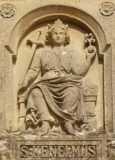Contents
Introduction
In the late fourteenth century (perhaps 1380), a cycle of wall paintings, illustrating the legend of St Kenelm, is known to have been made at St Kenelm’s church, Clent. As with nearly all church wall-painting, these were whitewashed over after the reformation. They were uncovered as part of a restoration of 1845-46, but were apparently ‘obliterated’ shortly thereafter. There are, however, surviving sources of information about this devotional decorative scheme.
Firstly, during the restoration of 1845-46, the architect, Richard Hussey uncovered the original paintings behind the whitewash and made the coloured tracings which are now in the Victoria and Albert Museum and are reproduced below. He did not, however, note the position of the paintings. We also have an account in The Rambler in Worcestershire by Mr John Noake, as well as some sketches and notes made on a visit to the church by two unnamed Edgbaston schoolboys, both from around 1845. Miriam Gill has combined information from these sources to reconstruct a plan of how the cycle of paintings would probably have looked.
Her diagram of the Chancel, or altar area, is shown below. The pointed shapes are the windows, the areas numbered 5 and some of 8 being the side walls of those windows.

The interior of the church today
Below is a video of the interior of the church. Traces of the earlier wall painting (item 4 below), can be seen immediately behind the pulpit in the unpainted area extending halfway up the Western window. The Twentieth Century St Kenelm window is also visible at the end of the video, on the Western wall of the church.
Tracings of Richard Hussey
Numbers in subtitles below refer to the diagram above.
The Coronation of King Kenelm (1)

The plot of Quendryda and Ascobert (2)

The vigil of the Cow over the Saint’s Body (3)

This appears to be the painting from the earlier wall painting cycle. (4)

Missing painting (5)
The Noake’s account refers to a man clad in purple dress with a large sword. No reproduction of this painting survives. Gill speculates it may have been St Paul. I would have thought it may more likely be Ascobert. The painting would have been on one of the side walls of the western window.
The body of the headless Saint held by angels (6)

The rule of Quendryda, the usurping Queen (7)

The procession of the body of Kenelm (8)

The dispute over Kenelm’s body (9)
This is known from a scene sketched by the schoolboys of a row of archers, very likely representing Worcester Abbey troops, who laid claim to the saint’s body.
Decorative element

Reference
Kenelm Cunebearn… Haudes Bereafed: A Reconstructed Cycle of Wall Paintings from St Kenelm’s chapel, Romsley. Miriam Gill. Journal of the British Archaeological Association, 149, 1996.

